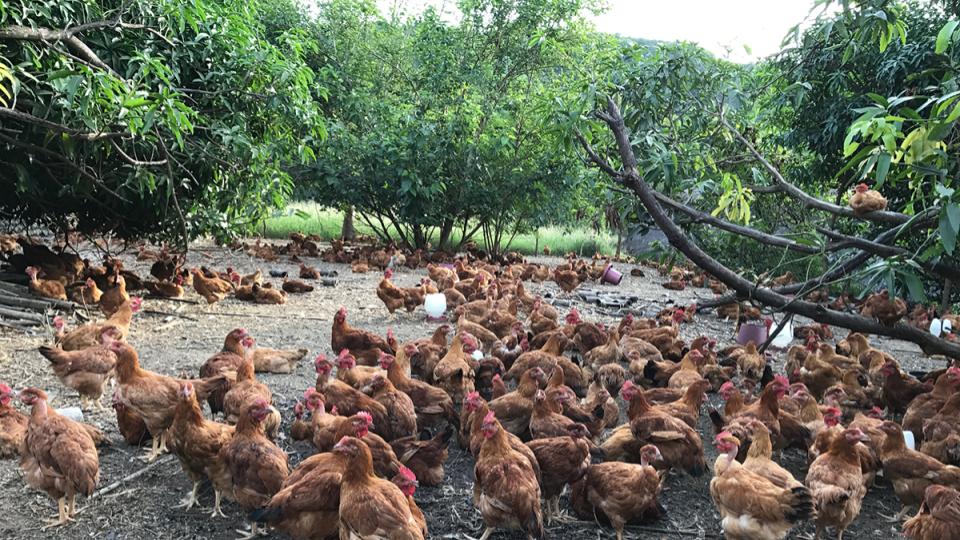
This is a very DETAILED tutorial for how to start a poultry farm in The Philippines in 2021.
In this new tutorial you’ll learn, step-by-step, how to:
- Decide if it will be profitable
- Calculate necessary capital
- Choose: egg vs. meat
- Build the best house
- Optimize production
- Keep your flock healthy
- Find buyers for your product
This guide is just for you.
Contents
- 1. Market Research
- FAO Agricultural Outlook 2019 -2028
- Example Philippines Poultry Farmer Success Story
- PSA – Philippines Statistics Authority
- Industry press
- Philippines poultry journalist contact
- Philippines poultry farming groups
- Philippines chicken trends
- Philippines Poultry Consumption
- Philippines Poultry Production
- Philippines Import duties
- Philippines poultry value chain
- Major poultry farms in the Philippines
- Good husbandry practices for Philippines poultry farmers
- Poultry farming advice in social media
- 2. Choose your model
- 3. Choose your market
- 4. Find out what consumers want
- 5. Get long term customers
- 6. Get trade sales
- 7. Sell direct to the public
- 8. Direct selling
- 9. Proximity to market
- 10. Poultry houses in the Philippines
- 12. Poultry farm operational layout and design in the Philippines
- 13. Registering your poultry farm business
- 14. Training
- 15. Type
- 17. Rearing system
- 18. Yield & performance
- 19. Production modelling
- 20. Secondary income streams
- 21. Estimating cost
- 22. Labour
- 23. Pricing and value proposition
- 24. Marketing
- 25. Estimating sales and breakeven
- 26. Funding
- 27. Growth and diversification
- 28. Advice
- Now, over to you…
Contents
- 1. Market Research
- FAO Agricultural Outlook 2019 -2028
- Example Philippines Poultry Farmer Success Story
- PSA – Philippines Statistics Authority
- Industry press
- Philippines poultry journalist contact
- Philippines poultry farming groups
- Philippines chicken trends
- Philippines Poultry Consumption
- Philippines Poultry Production
- Philippines Import duties
- Philippines poultry value chain
- Major poultry farms in the Philippines
- Good husbandry practices for Philippines poultry farmers
- Poultry farming advice in social media
- 2. Choose your model
- 3. Choose your market
- 4. Find out what consumers want
- 5. Get long term customers
- 6. Get trade sales
- 7. Sell direct to the public
- 8. Direct selling
- 9. Proximity to market
- 10. Poultry houses in the Philippines
- 12. Poultry farm operational layout and design in the Philippines
- 13. Registering your poultry farm business
- 14. Training
- 15. Type
- 17. Rearing system
- 18. Yield & performance
- 19. Production modelling
- 20. Secondary income streams
- 21. Estimating cost
- 22. Labour
- 23. Pricing and value proposition
- 24. Marketing
- 25. Estimating sales and breakeven
- 26. Funding
- 27. Growth and diversification
- 28. Advice
- Now, over to you…
1. Market Research
The Philippines Poultry Industry Status
Your first step is reading up on the status of the poultry industry in the Philippines.
First stop, getting your hands on the official industry statistics.
(This is why I wrote this article)
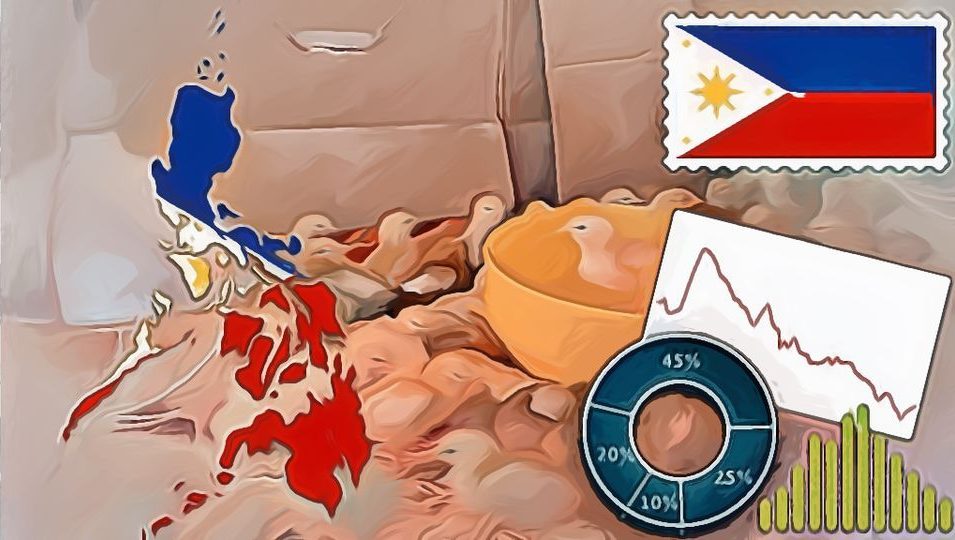
Philippines: Poultry Farming Industry Statistics (Updated for 2021)
I plan on updating it 4 times each year with EVEN more useful market data…
…all in an effort to help you grow your poultry farm business.
Also,
For up-to-date news, views and commercial issues in the Philippines poultry world,
This archive of articles will help you learn quickly:
https://www.thepoultrysite.com/country/PH
FAO Agricultural Outlook 2019 -2028
The UN Food and Agriculture Organisation produce a global report on farming.
It looks forward about 10 years and will give you an idea of what the expert view is on future trends.
See how the Philippines’ poultry trade lines up with other Asian economies…
“Production of eggs, pork and poultry is projected to expand annually by 1.3% in Paraguay,
2.1% in Peru, and 1.9% in Viet Nam, 2.2% in Indonesia and 2.0% in the Philippines.”“[Increasing meat production – ] Philippines and Viet Nam – due to rapidly increasing domestic demand“
OECD-FAO Agricultrual Outlook 2019 – 2028
Example Philippines Poultry Farmer Success Story
Isn’t it great when people a few steps ahead take the time to share (and give back)?
Looking no further than these two examples, we prove that it is possible for non-farmers succeed, starting from scratch.
Meet Emerson Siscar, IT professional turned proprietor of Batangas Free Range Chicken…
Photo credit: © Gregg Yan
https://www.thepoultrysite.com/articles/why-free-range-is-booming-in-the-philippines
And, introducing Dwight Tamayo – career nurse and now, poultry farmer and social media mogul:
https://www.agriculture.com.ph/2020/06/21/masbate-poultry-farmer-is-also-an-internet-influencer/
PSA – Philippines Statistics Authority
The Philippines Statistics Authority (PSA) is the official office of national statistics for the Philippines.
Their job is to “…collect, compile, analyse and publish statistical information on economic, social, demographic, political affairs and general affairs of the people of the Philippines.” (Source)
And, yes – they have ALL the agri data too, of course, this includes poultry and eggs.
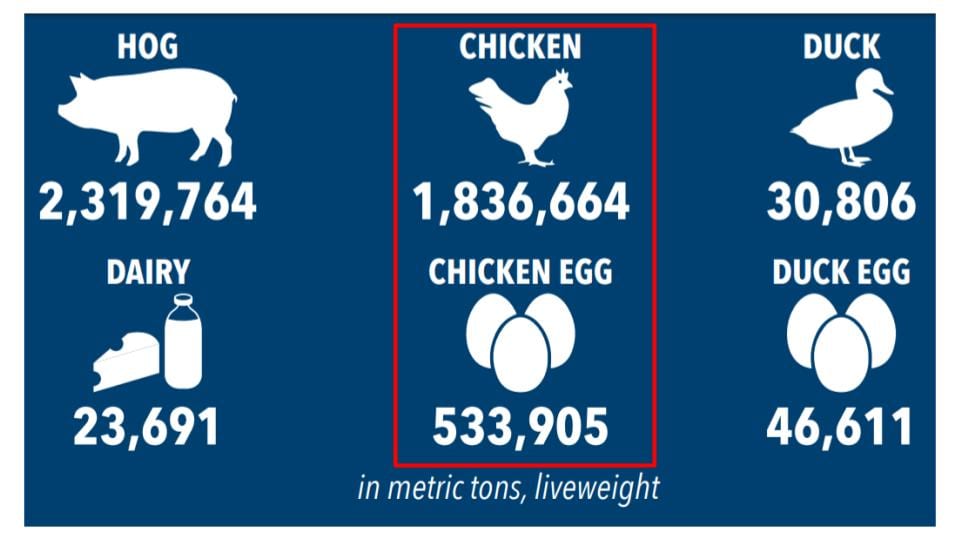
(Philippines Statistics Authority)
You’ll find their website here: https://psa.gov.ph/
They also have a Twitter account, which is an ideal method for being first when they release something new:
Visit the PSA Twitter profile (click here)
Industry press
The Philippines poultry industry is widely covered by the press.
And this presents a treasure trove of information and insight on what’s current and what’s hot…
https://business.inquirer.net/319142/price-freeze-on-pork-poultry-stays-until-april-8
Philippines poultry journalist contact
An advanced tip for digging deep on who has the latest and greatest scoop on things poultry in the Philippines,
Try what I call: Meet A Journo.
It’s three-step and it can lead to golden PR opportunities for your poultry farming business.
- Find a quality, high-profile poultry farming article on the Philippines.
- Take note of the journalist who authored the piece.
- Search for their Twitter account by typing: ‘[journalist’s name] Twitter‘ into Google.
Get notified every time they publish something new.
(Plus, get their attention by sharing with them something they might value.)
For example,
- This article on free range chicken farming in the Philippines was published on The Poultry Site
- It was written by Gregg Yan, an environmentalist who used to lead communications for the World Wildlife Fund.
- Typing into Google Search: ‘Gregg Yan Twitter‘ we find Gregg’s Twitter profile (why not get in touch?)
Philippines poultry farming groups
There are quite a few QUALITY agribusiness advice groups for the Philippines online…and Facebook is the primary source.

Many of them have a poultry category. Yet, quite a few are actually specialist poultry groups.
Here’s how you find them easily –
Type this into Google Search:
intitle:’farming’ inurl:’facebook’ inurl:’groups’ philippines
Sign-up and give them a try.
Pro tip: before deciding whether its worth joining any particular group,
Here are some features to look out for to help you choose:
- Access: Public or private
- About page group description
- Group history i.e. name and identity changes
- Activity: number of members and posts today
- Group rules
Once you’ve been briefed of these, you’ll know if a group holds value for you.
n.b. ALWAYS go for a group with lots of recent activity, so you don’t waste time posting into thin air.
Philippines chicken trends
Staying on trend in business always give you lots of room for grwoth.
After all,
Knowing what your customers want today and (are likely to want) tomorrow helps you keep your business in demand.
Want a way of finding out what poultry trends in the Philippines are taking off?
Use Google Trends.
It works very similarly to Google Search, you type in a phrase like:
‘Chicken‘
…and Google Trends literally tells you what’s trending in search right NOW.
For example,
Searches for Rhode Island Red chicken breed in the Philippines have gone up by 250% over the last 12 months.
Philippines Poultry Consumption
Poultry consumption is the demand for your farm’s supply.
Que: “How much chicken meat is eaten in the Philippines each year?“
Ans: “As of January 2020, almost two million metric tons of chicken meat was consumed in the Philippines [within the previous 12 months].” (Source)
“…thanks, but I have on more question…”
Que: “How many eggs are eaten in the Philippines?“
Ans: “Egg consumption per capita reached 4.58 kg in 2018 in Philippines, according to Faostat.” (Source)
Pro tip: the consumption of poultry produce (eggs and chicken meat) per country is quoted as per capita.
In other words, how much of each food is eaten by each person on average.
This is calculated by dividing the overall volume of food by the number of residents.
Philippines Poultry Production
As you can probably imagine,
The Philippines already produces a MASSIVE amount of chicken and eggs.
In fact,
Statistics have it that “…the total volume of chicken production in [the Philippines during] 2019 was 1.93 million metric tons, liveweight.“
But don’t be discouraged,
In business, there is always room for improvement.
The are just so many different types of consumers out there…
…that you can never have enough producers.
This article on AgFishTech Portal, called Chicken Production – has a really useful list of common poultry breeds in the Philippines:
Philippines Import duties
As a soon-to-be poultry farmer in the Philippines, the news is…
…you’ve got internal competition, AND…
…foreign import competition too.
Recently, Quezon Rep. of the House Committee on Agriculture and Food – Mark Enverga, was quoted as saying:
“The poultry producers [in the Philippines] deserve to be heard and be assured that the government is doing its share to combat the problem arising from high levels of importation of poultry’s products, while we are experiencing an oversupply of broilers in the market, he added.” (Source)
The Philippines (just like any country) has its own internal Government targets and policies on imports.
Import duties or tariffs are often used as a means of artificially loading the costs of imported goods…to favour homegrown produce, by price benefit.
Here’s a couple of recent USEFUL articles to help you learn this topic:
Philippines poultry value chain
Markets move by value.
Raw materials and inputs are harvested refined and honed to suit market demand and tastes.
It all happens step-by-step by a chain of events.
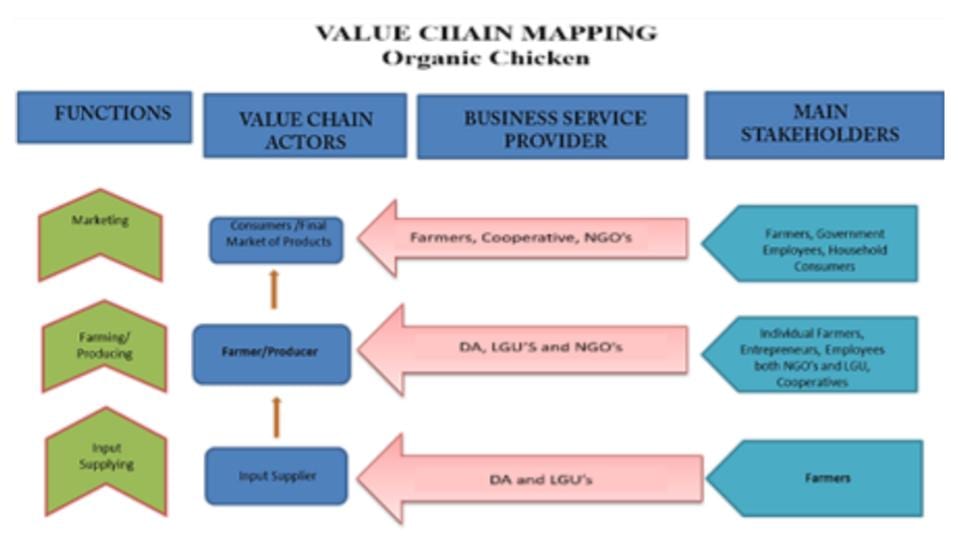
(Source)
Each contributor within the chain does ‘their bit’ to make the product that little bit more ready for consumption.
Critical to becoming a most valued participant in the chain…
…is knowing your place PLUS who exists both upstream and downstream of your farm.
Articles like this one will get you thinking collaboratively:
https://www.da.gov.ph/phs-egg-processing-capital-demonstrates-innovation-in-the-value-chain-approach/
Pro tip: type this into Google Search for more info on the people that make ‘poultry’ tick in the Philippines:
‘Philippines value chain’
Major poultry farms in the Philippines
When researching the marketplace for your poultry farming business plan,
It’s worth taking a good look at your market leaders for tips on success.
Analysing WHAT they do really well, HOW they do it and WHY…
…then consider how you could make that work for you.
Here’s a Dun & Bradstreet list of some of the biggest and best in the industry:
https://www.dnb.com/business-directory/company-information.poultry-egg-production.ph.html
Good husbandry practices for Philippines poultry farmers
Handling your flock well properly to better performance.
Birds are sensitive and respond favourably to the right care.
Whilst there is a universally accepted approach to poultry farming, each country has its own unique challenges.
Because of this, governments write their own best practice standards on raising chicken for eggs or meat.
Here are the Philippines’ national standards for broiler and layer husbandry (best practices)…
Download Now:
https://members.wto.org/crnattachments/2016/SPS/PHL/16_1747_00_e.pdf
Social media is a rich source of peer-to-peer advice.
Often what we need when we start new ventures is ‘an experienced viewpoint’ – to get us on the right rack.
This is where social listening comes in.
(The art of picking up the conversational thread on social media.)
And by far online the no.1 ‘most valuable’ place to listen in for poultry farming peer-led advice for the Philippines is:
Reddit. (Here are some useful threads to get you started.)
Take this one – Poultry farming with tunnel ventilated houses (quite an advanced level topic):
Poultry farming with Tunnel Ventilated houses
byu/2klude inphinvest
This is a classic poultry farming start-up enquiry from a beginner:
Question sa mga businessman
byu/onated2 inPhilippines
Here, the discussion is about a growing social trend of farm owners selling up in the Philippines:
Why are Filipinos leaving the farms?
byu/CorneliusTullius inPhilippines
Domestic farmers team up to appeal Governmental favour towards imported chicken:
Groups buck gov’t move to import chicken
byu/SEND_ME_UR_DRAMA inPhilippines
And finally, a question related to becoming a contract broiler grower in the Philippines:
The Chicken Business – Contract Growing
byu/killercats10 inPhilippines
Pro-tip: to find more of these useful threads type this phrase into Google Search:
‘poultry farming reddit inurl:’philippines’
2. Choose your model
Your first decision is choosing your business model.
What style of poultry enterprise do you want to have?
They all have their appeal, in a way, but the choice is definitely one of preference.
Here’s my list:
Independent
Go it alone – truly a DIY approach to starting a poultry business.
High risk/reward.
You take all the risk, but then again you don’t share any profits either (maximum reward).
Pros – sovereignty to make your own decisions, greater earnings…
Cons – nothing ready-made for you, time and money spent ‘working things out’ already solved by established operators…
Co-Op
Join forces with other producers to magnify bargaining power in your market.
Also,
Benefit from shared economies of scale and efficiencies that would be otherwise lost as an independent.
Pros – lean on founders for the benefit of their experience and expertise, lower input costs
Cons – joint venture weaknesses, your produce in tied u pin forward obligations with the Co-Op
Contract Poultry
Sign up to serve a ready-made poultry outfit that will supply your farm with optimal input,
As well as, buy 100% of your stock at the point of fulfilment.
Pros – everything but keeping the chickens is done for you
Cons – it’s not your business…your farm is really ‘owned’ by them (what they say goes), tournament pricing
Joint Venture Poultry
Innovative and works to mutual strengths.
One business feeds another one just where they both need it the most.
Pros – more focus on what you do best, shared collaborative insights
Cons – very fragile because success depends a lot on strategic alignment, can be costly to duplicate communications
Franchise
You buy the license to trade under the name of an existing and established poultry brand.
They provide you with reputational headstarts and a tried business model.
Pro – they give you a winning formula, lose no time dreaming up a brand etc.
Cons – still require HUGE effort to make ‘their way’ succeed for you, large capital outlay to recoup from ‘go’
Buy a poultry farm in the Philippines
Take on a going concern as is and steer it into increasing rounds of profit.
Pros – business is already trading, has some trading footprint already
Cons – can be VERY difficult to see if it is actually making money, independent valuation
3. Choose your market
Finding your niche in the poultry market is critical.
The goal is:
Moving away from the price wars of commodity trade,
And fitting in where your customers don’t care about price but want to award you with their vote of confidence.
How is it done?
Discover the need.
Investigate the crux problems of poultry buyers in A-Z scenarios and make a plan to serve the need.
This is PROFITABLE business planning.
For example,
This article talks of such an UNTAPPED poultry demand in the Philippines:
“There is a big potential niche market for native chickens that is waiting to be tapped.
We were talking with a consultant of a big chain of restaurants and he was bewailing the difficulty in sourcing native chickens that are more or less uniform in size and meat quality.” (Source)
Which brings us on to…
4. Find out what consumers want
The key to starting a successful poultry business in the Philippines (or anywhere) is:
Finding out what customers want.
This drives transactions.
Customers pay for having their problem solved.
They don’t pay for ‘good’ or even ‘great’ products and services.
They want their itch scratched.
Get researching today.
Any store selling free range chicken and eggs?
byu/linux_n00by inPhilippines
Pro-tip: I can’t say it enough – Reddit is a gold mine of customer research and insider tips. Join r/Philippines.
5. Get long term customers
Customer lifetime value is BIG in marketing right now –
And the good news is that it is totally relevant to selling eggs and chicken meat in the Philippines.
The concept is really simple.
Going the long run with customers take more effort PLUS you need to invent genuine reasons to return,
BUT if type of relationship marketing is achieved, it equals MASSIVE ROI.
Just think it through:
The average citizen of the Philippines eats 13.7 kilograms per year,
So a family of 4 (2 adults and 2 children) might eat ~40kg of chicken per year
(…or 20 chicken per year / just under 2 a month / i.e. 1 chicken every 2 weeks).
At recent 2020 prices (Php 74.05 per kg),
You would make Php. 2,962.00 revenue in a year from one household alone.
@ a net profit margin of, say, 18% = you would earn…
- Php. 533.16 in take-home pay from that family alone in a year.
On the flipside,
Marketing for the short term gain of getting 10 new customers might win you:
10x Php.148.10 = Php.1481.00 in the 1st time sale (selling 2kg birds).
@ 18% net profit =
- Php.266.58 take-home pay.
So, the profit of KEEPING one household engaged to buy from you consistently for a year is:
100% more rewarding than getting 10 new customers.
FACT.
6. Get trade sales
Selling to business buyers has an appeal for poultry farmers.
- Large volume transactions.
- Repeat business.
- Consistent cash flow.
But what does a trade buyer look like?
And does a new farmer really have a chance at attracting them?
This article, on Smallholdings for Sale, “How To Make a Profit Selling Produce To Restaurants From a Smallholding“
Reveals the results of a survey taken of 383 expert chefs across America.
They were asked various questions about their local produce buying habits.
One of the most encouraging take-home points was this:
When asked,
What is your preferred source of locally grown produce?
Here’s what they said…
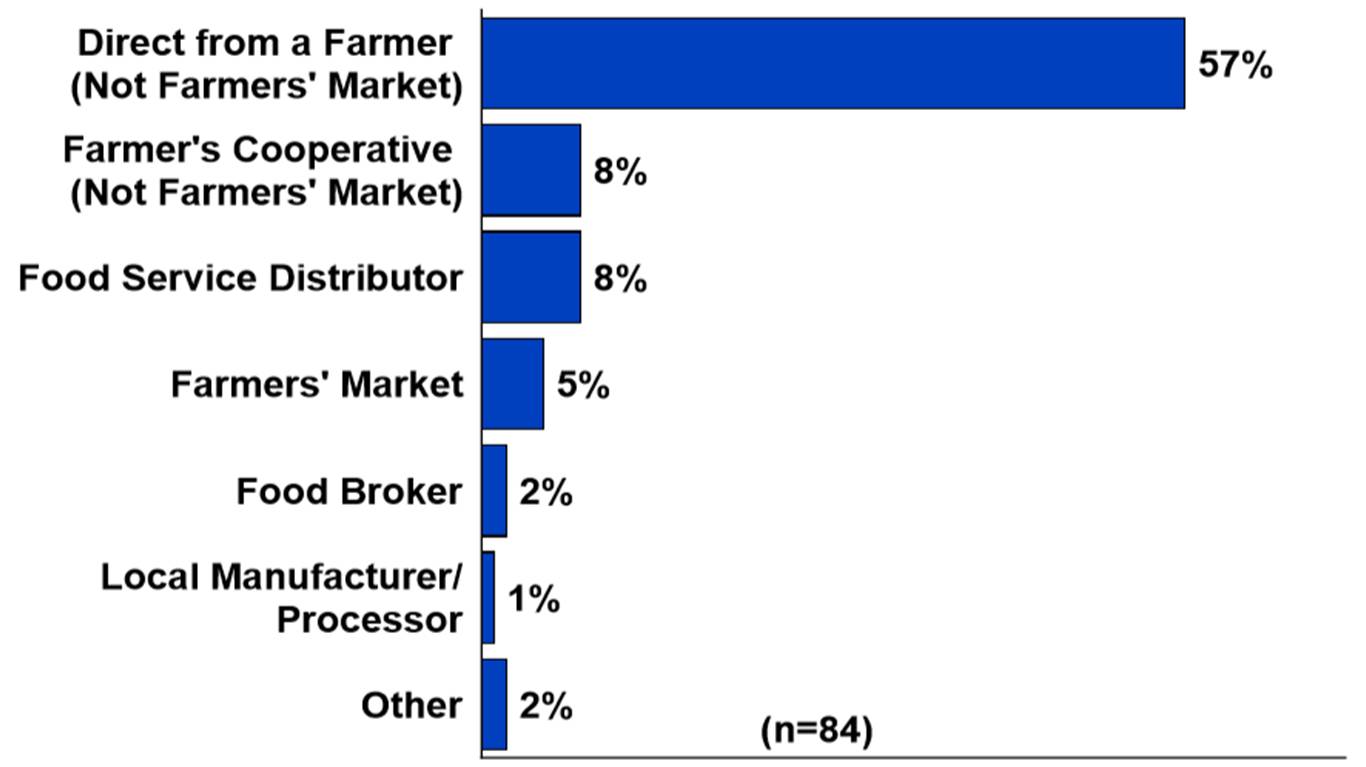
81% of respondents said, “Direct from a farmer.”
Even more of a green light was this response to the question,
What would encourage you to increase the variety of locally produced purchases?
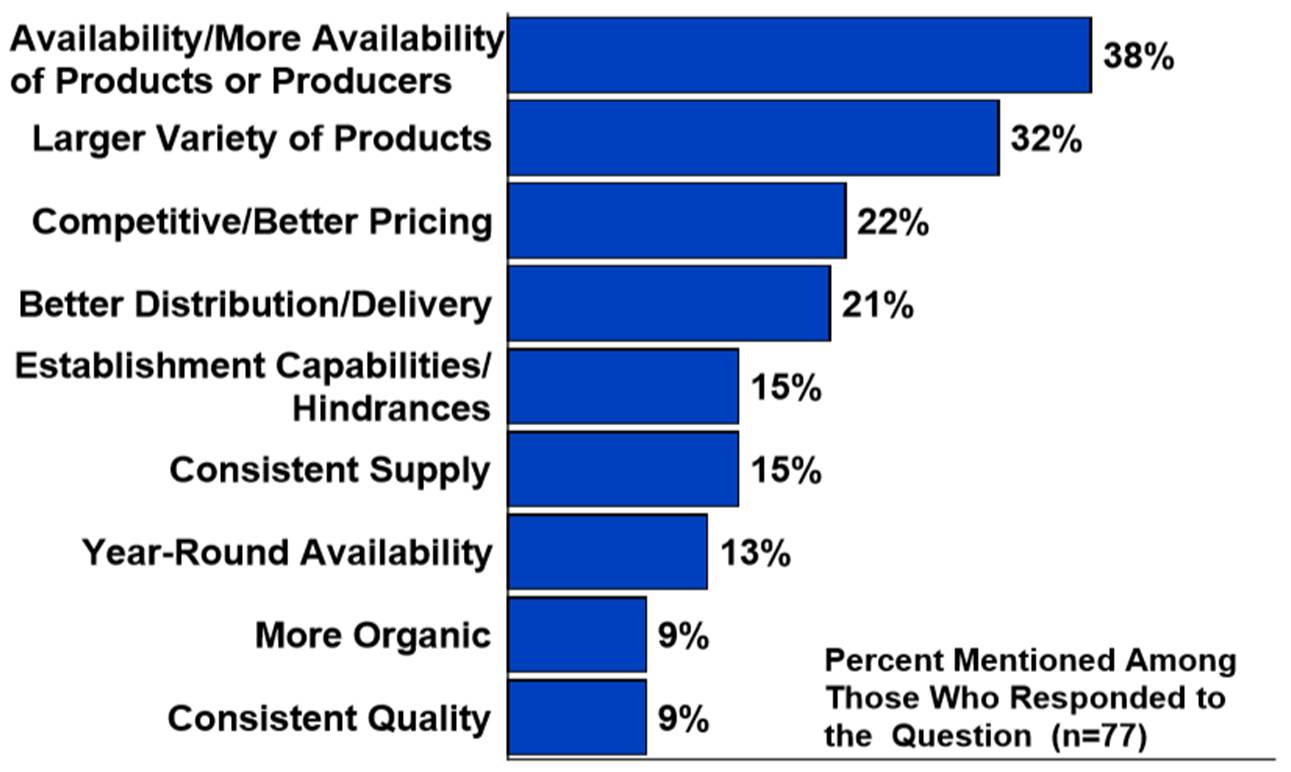
As competitive as the US agricultural produce market is,
Roughly 1/3rd of the chefs said, they wished there to be more producers and growers to buy from.
7. Sell direct to the public
As well as trade sales, your poultry farm will benefit from a backbone of sales to households.
This article:
5 Qualities To Copy From Top Selling Produce At Farmers Markets – is packed with MANY practical and actionable pointers to take away for selling produce to the public successfully.
8. Direct selling
Direct selling is an art – and a very profitable one too.
It gives you a way of approaching people 1-to-1 and selling them that deal that they need and that you want.
In involves many of the least liked sales related activities, like:
- scripted phone-based cold calling
- writing sales letters
- door knocking
…which is really difficult to get right if you don’t know how.
BUT if you do, it can single handedly grow you a very viable poultry farming business.
In fact,
So valuable is this skill,
That I recently decided to write up a 6,012 word Ultimate Guide to Direct Selling for Poultry Farmers for my premium newsletter subscribers.
It’s a step-by-step blueprint that led to me making 6-figure client revenues in my commercial sales career.
You can read my guide here.
9. Proximity to market
A big part of selling successfully is being available and consistent.
In other words,
VISIBLE.
Not just on ‘market day’ either,
But throughout the week.
However, not without an invitation of course.
As I said before, to close sales successfully you need to establish genuine reasons to return.
And having them, USE every one of them to maximize profit.
Go to market.
https://thebigbookproject.org/poultry-farming/project-report/location/market/
10. Poultry houses in the Philippines
Here is a couple of examples of poultry housing in the Philippines to help you visualise your own:
Brown&Free Eggville – Manolo Fortich, Bukidnon, Philippines
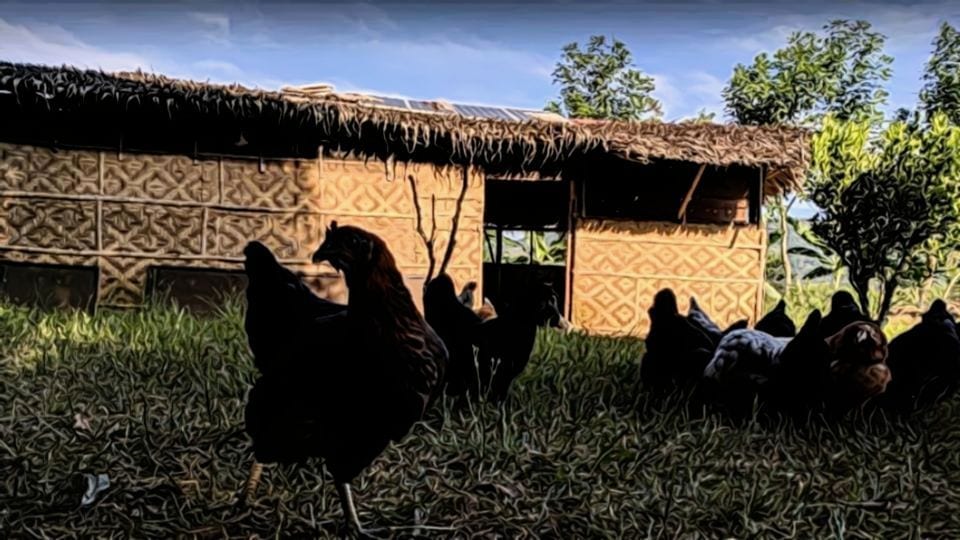
Bulacan Nueva Ecija Tarlac Farm Fresh Eggs – Riverside St., Bulihan, Malolos City, Bulacan (10,959.13 km)
3000 Malolos, Philippines

12. Poultry farm operational layout and design in the Philippines
To really understand the poultry business – you’ve really got to see it in action.
So, no better than a handful of videos to help you get the picture.
Here are my choice of VIDEOS showcasing poultry farms in the Philippines and the people that run them:
A day in the life of a poultry vet in a commercial, controlled-environment broiler farm in the Philippines:
A detailed presentation about the layer poultry business start-up by Dwight Tamayo (an experienced cage layer farmer in the Philippines):
An agribusiness introduction to free-range chicken farming in the Philippines:
A ‘how to manage native chicken in the Philippines’ tutorial:
Dwight again, showing you what he does every day as a layer egg farmer in the Philippines:
13. Registering your poultry farm business
Your poultry farming business will need licensing and registration with various Philippines governmental departments including the DA.
Here is a very neat summary of the types of official paperwork you will need:
https://businessdiary.com.ph/438/how-to-start-a-poultry-farm-business/
Also, there are government incentives that poultry farmers can register to benefit from like this one:
Selected farmers receive native breed, free-range chickens and feed from the DA:
“This after the Department of Agriculture (DA) in Central Visayas delivered and turned over to each of the farmers’ organizations some 50 pullets (young hen) and 10 cockerels (young rooster) of upgraded free-range chickens with two sacks of feeds under the Expanded Livestock and Poultry Production and Livelihood Project…”
Offering your household more food security and additional income:
“In a statement on Friday, Dr. Zeam Voltaire Amper, DA-7 livestock program coordinator, said that this project would enable the farmer-household beneficiaries to produce their own food and have the opportunity to raise additional income for their families.”
14. Training
The humble agricultural bulletin is one of the oldest, yet GOLDEN, methods of learning farming.
Extension services like this one:
…date back to 1889 and are STILL some of the most detailed farmer training manuals around.
There are many poultry examples, like:
Are a great introduction to farming poultry on a small scale.
Pro-tip: for next level poultry business training & tools (AND to learn the most profitable strategies) – subscribe to receive my weekly, premium email newsletters & PDFs.
15. Type
Deciding on the type of poultry business to run can be difficult as a beginner.
Becoming familiar with “…what kind of farms exist and for what reasons…” grows your confidence to make the right choice.
Here’s a quick list to help you on your way:
- Breeder:
- holds pure stock for the purpose of breeding specific lines of bird to meet commercial demand.
- Hatchery:
- hatches select breeds of birds and sell either eggs or day-old chicks to farmers.
- Rearing:
- raises day-old chicks through a variety of ages and sell live birds to farmers.
- Layer egg farm:
- rears specialist egg-laying birds, either from day-old chick or 16-18 week old (Point of Lay, PoL) for optimal performance i.e. most, high-quality eggs at a profit, and sells them
- Broiler meat farm:
- grows table meat birds taken from day-old chick up until they reach a marketable weight, usually 6-7 weeks, hence 45 days chicken – and sold
- Packer:
- buys eggs wholesale from farmers and packages them for resale
- Equipment vendor:
- buys poultry farming equipment like feeders and drinkers from manufacturers and sells them on
- Agent:
- arranges deals to supply business buyers with wholesale eggs or chicken meat and takes a commission for his sales effort
- Feed miller:
- takes bear grain and other ingredients and mills them to produce poultry farm feed rations for layer and broiler farms
- Native breeds: breed local birds and selling to niche buyers
Local chicken breeds can be very profitable to raise.
You can find some restaurant clients willing to pay premium prices for the right product.
This is a comprehensive guide to the most popular native breeds of chicken in the Philippines:
https://www.thepoultrysite.com/articles/farming-heritage-chicken-breeds-of-the-philippines
17. Rearing system
There are four main styles of poultry farm rearing in the Philippines:
Organic – chickens are raised on ample enough grounds to run this
Free poultry – birds openly graze and forage out in the open all-day
Deep litter – birds grow on the litter covered floor of the poultry house and stay indoor most (of all) of the time
Cages – birds grow or lay eggs whilst in cages throughout their entire lifetime on the farm
For a thorough breakdown of the pros vs. cons of poultry rearing systems, I recommend this post:
“How To Select a Good Poultry Housing System”
18. Yield & performance
This is where the gears of your poultry business start to grind.
The yield metrics of poultry farming are all based on the performance of the individual bird.
Once you know what the capacity of each bird is – you then know what your business can do.
It sets a physical ceiling.
So, here are YOUR NUMBERS (I highly recommend you memorise them):
Typically, commercial broiler meat chicken like the Cobb 500 strain:
- take 6 weeks to reach the marketable weight and size
- their weight at this age is approximately 2.952 kg
- consumes 5.348 kg of feed throughout the 6-7 week period
- 68.8% of the broiler’s carcass results in saleable meat (the rest is by-product)
- have an average mortality rate of 5%
Commercial egg-laying chicken like the HyLine Commercial Brown:
- become unprofitable at 72 weeks of age (after which they become spent)
- begin laying eggs at 18 weeks of age
- hit peak egg production of 92% hen-day egg production at about 22 weeks of age
- lay about 360 eggs each in their 72-week commercial laying cycle
- have a 92% survival rate throughout the rearing cycle
- peak egg weight during 72-week production is 65.5 g
19. Production modelling
Beyond the performance capacity of the individual bird,
Your profits in poultry farming rest in engineering the optimal poultry production model.
What is this?
It’s basically taking the capacity of each bird and multiplying it until you get your desired output of eggs or meat.
Mathematical problem solving (with financial management accounting).
For example,
When you buy a new batch of day-old layer chicks,
They need to be raised for 17 weeks before you can expect your 1st egg.
Also, when a flock reaches 72 weeks of age they get culled.
In both cases, if this was your only flock – your business would have a pause in cash flow…
…whilst you wait for your new replacement flock to become productive i.e. 17 weeks.
What’s the answer to keeping your cash flow consistent?
Adopt a multiple-flock production model.
Pro-tip: I recommend subscribing to my premium email newsletter series (subscribers only), called Poultry Project Reporter.
(I publish every email as a PDF version in the archive.)
These are emails are the most deteiled deep dive analysis of common layer and broiler production systems. Including profit calculations and investment projections – like in the screenshot above.
20. Secondary income streams
Your main income as a poultry farmer will be earned either from meat or egg sales.
However, there is plenty of side income potential too.
For example,
Layer farmers can also earn from selling:
- manure for fertiliser
- spent hens
- used feed bags (hessian)
Broiler farmers can also earn from selling:
- manure for fertiliser
- by-products e.g. feathers, blood, head, feet etc.
- used feed bags (hessian)
You can make, perhaps 10-12% of your primary poultry income in these kinds of supplementary sales.
21. Estimating cost
Accurate estimation of cost requires supplier quotes.
As it goes, suppliers are often shy (by nature) of publishing pricelists in the public domain.
You only have to look for poultry feed prices for the Philippines and you’ll see what I mean.
Rare sources like this video share footage of some real pricing for poultry feed, for example.
Aside from this, I came across a rare feed price list published by an agent,
A bit dated – but valuable for getting an idea of how feed pricing work (especially volume discounts):
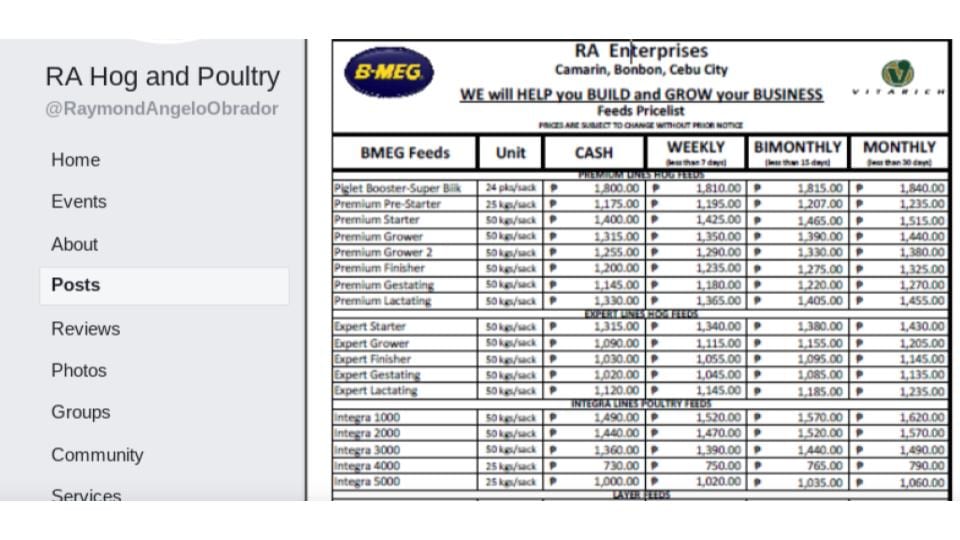
(Source)
22. Labour
Poultry farming can be a very lean business model when it comes to labour.
Many families in the Philippines work the farm themselves with the help of the household.
A backyard poultry business plan like this one shows just how feasible it is to start small and grow with only household labour.
Beyond this, larger commercial operations require employed staff too.
Poultry stockmen are the industry staple.
They are the eyes, ears, hands and feet of the operation…
…making sure every ounce of input gets converted into optimal output.
23. Pricing and value proposition
Don’t get sucked into thinking the cheapest chicken or eggs on the market attract the most sales.
It’s not so,
With a greater demonstration of value, price becomes of lesser importance (always) in buseinss.
In other words,
People don’t mind paying more – when they see what is on offer being far in excess of the value of the cost.
This quote from an organic free-range farmer in the Philippines, says it all:
“Organic free-range chicken meat is a premium item, but production must always comply with strict standards,” explains Emer.
“Feeds can’t contain animal protein so we make a special mixture of corn, soy and vegetable pellets.
We don’t use antibiotics or growth hormones, so our brown broilers take a longer time to reach a live weight of 1.5kg to 2kg – about 75 days compared to the 28-day-old chickens produced by factory farms.
Still, our chickens retail for much more – up to 400 pesos or US$8 per kilogram compared with around 120 pesos or $2.5 for non-organic chicken, so the extra time, effort and love we give them pays dividends.
(Source)
24. Marketing
There are so many different ways to market your poultry products.
The internet is awash with so many practical guides to this.
So,
Here’s what I did, I got…
STRATEGIC.
Marketing strategy (a step-by-step blueprint for marketing success),
Is the winning touch that every small business needs. Your poultry farm included.
The principles in this premium email newsletter are PROVEN for setting your poultry business to lead its market.
Build your winning marketing strategy today.
25. Estimating sales and breakeven
I recently wrote a series of detailed sales and profit analyses using Poultry Project Reporter software.
Having searched far and wide online – I can safely say there is nothing quite like the depth they go into.
I published them to help start-up poultry farmers understand…
…how to plan a PROFITABLE poultry business.
For example,
In the series, I illustrate in which week you can expect common broiler production models to start making a profit:
And also, when the overall break-even ROI point occurs:
(*Don’t let the currency put you off – the principles behind the examples are universal to any country.)
If you are planning a poultry farming business right now, I highly recommend downloading the PDF version of the series now.
You’ll find the broiler farm version here, AND the layer farming one here.
26. Funding
Funding enables the start-up process.
However, contrary to what most people think – getting finance is not mandatory.
In fact,
Debt from finance is harmful to profits and growth.
It puts you at a deficit from day one…giving you a much steeper mountain to climb ahead.
A question, I often get asked by my email subscribers is:
“Is it possible to start my poultry project as a backyard operation and scale it without borrowing?“
Here’s my answer every time:
“Poultry Farming Loan – Unmissable Reasons Why You Don’t Need One!”
27. Growth and diversification
Once you hit a formula that works for you in business – the natural next steps are:
Grow and/or diversify.
In other words,
- more
- different
The experience gained from your early years of trade will be invaluable for giving you a good sense of direction.
But with any type of change in business strategy always factor in the COST.
- Time to research
- Money in invest
- Losses whilst finding your feet
Yes, upscaling your operation can make sense if you see a profitable opening,
But being realistic about the cost will help you make better decisions.
28. Advice
Expert poultry business advice can make all the difference to the quality of your future earnings.
But detailed, yet affordable poultry advice can be quite hard to come by.
This is why I launched my premium subscription services earlier this year,
They include:
- poultry business planning templates
- egg & chicken production calculations
- PDF sample plans and data
- premium newsletters
So, if you are thinking of starting a poultry farm, or have one already and want to grow your profits:
I recommend you subscribe today.
PLUS,
I developed and released a web-based software for helping you write a winning poultry project proposal:
…it’s fastest and most flexible way to build your winning layer or broiler proposal.
It auto-calculates all your financial projections – without you doing any maths.
And, it helps you build profit scenarios to work out the most financially rewarding strategy for your business.
I recommend you use if you are planning your poultry business now.
Now, over to you…
Are you starting a poultry farming business in the Philippines?
Or, are you just thinking things through?
Either way, I’d be interested to hear from you today.
Leave me a comment below.
Photo credit:
This is very informative, I want to start my poultry business soon in the Philippines.
BCK27
What an inspiring post on starting a farm! Your insights truly highlight the rewards of this venture. For those interested in scaling up, joining feed mill construction forums can provide invaluable resources and tips. Keep sharing your knowledge—it’s motivating for all aspiring farmers!